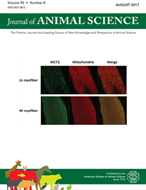-
Views
-
Cite
Cite
J. Arango, I. Misztal, S. Tsuruta, M. Culbertson, W. Herring, Estimation of variance components including competitive effects of Large White growing gilts, Journal of Animal Science, Volume 83, Issue 6, June 2005, Pages 1241–1246, https://doi.org/10.2527/2005.8361241x
Close - Share Icon Share
ABSTRACT
Records of on-test ADG of Large White gilts were analyzed to estimate variance components of direct and associative genetic effects. Models included the effects of contemporary group (farm-barn-batch), birth litter, pen group, and direct and associative additive genetic effects. The area of each pen was 14 m2. The additive genetic variance was a function of the number of competitors in a group, the additive relationships between the animal performing the record and its pen mates, and the additive relationships between pen mates. To partially account for differences in the number of pen mates, a covariable (qi = 1, 1/n, or 1/n½) was added to the associative genetic effect. There were 4,946 records from 2,409 litters and 362 pen groups. Pen group size ranged from 12 to 16 gilts. Analyses by REML converged very slowly. A grid search showed that the likelihood function was almost flat when the additive genetic associative effect was fitted. Estimates of direct and associative heritability were 0.15 and 0.03, respectively. Within the BLUPF90 family of programs, the mixed-model equations can be set up directly. For variance component estimation, simple programs (REMLF90 and GIBBSF90) worked without modifications, but more optimized programs did not. Estimates obtained using the three values of qi were similar. With the data structure available for this study and under an environment with relative low competition among animals, accurate estimation of associative genetic effects was not possible. Estimation of competitive effects with large pen size is difficult. The magnitude of competition effects may be larger in commercial populations, where housing is denser and food is limited.





